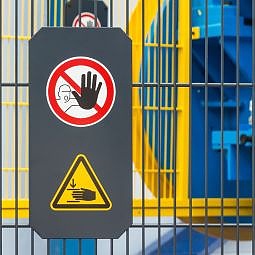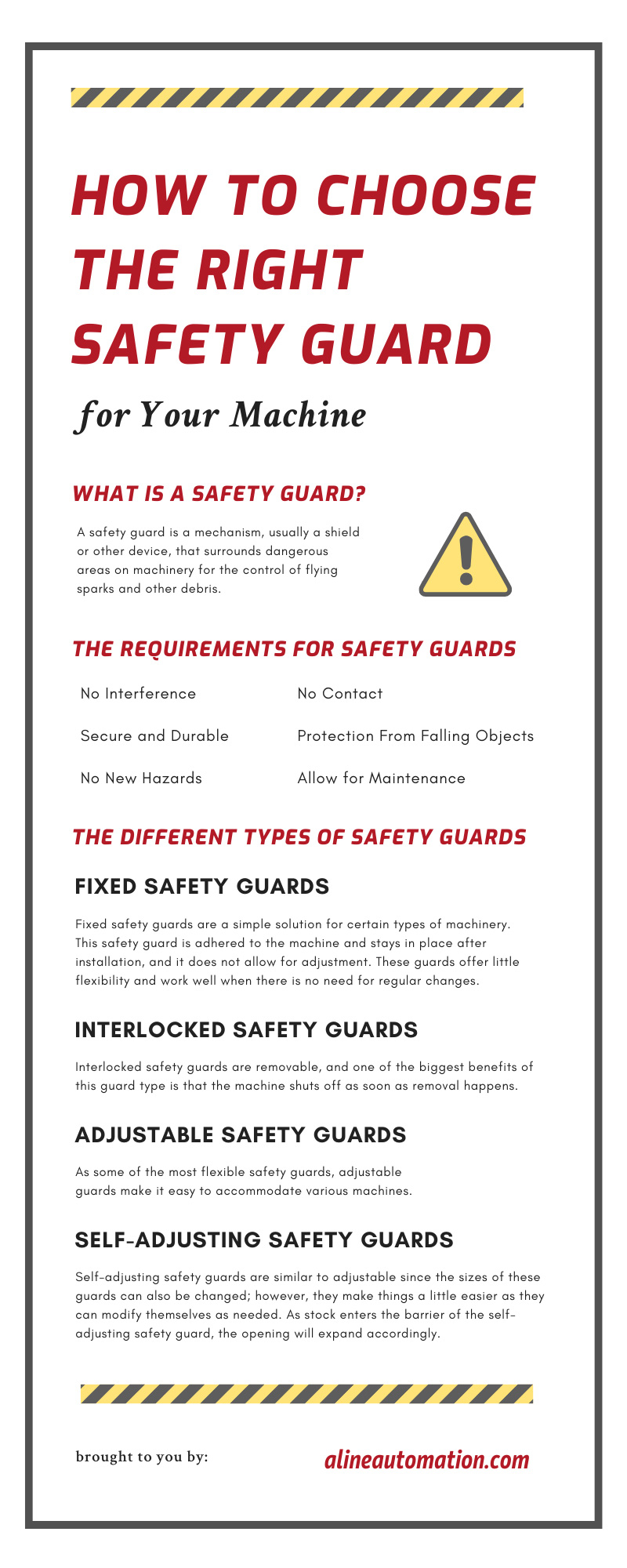
The Occupational Safety and Health Administration (OSHA) develops the standards for safety guards on machinery to ensure that all workers and employees have the protection they need while on the job. These standards are in place not only to protect employees, but to protect management as well. A company is liable when injuries occur, so using safety measures from the start is essential. To help ensure workplace safety, discover how to choose the right safety guard for your machine and learn more about why it matters.
A safety guard is a mechanism, usually a shield or other device, that surrounds dangerous areas on machinery for the control of flying sparks and other debris. It also serves to keep body parts from accidentally encountering hazardous areas. Hazardous components of machinery include the following:
• Rotating parts
• Reciprocating arms
• Moving belts
• Cutting teeth
• Shearing or impacting
• Punching
• Transversing
The three most common areas of machinery where injuries occur are at the point of operation, through power transmission spots, such as at pulleys and belts, or near any other moving parts.
Since OSHA sets the standards, there are specific requirements for safety guards that businesses must follow. Let’s look at each standard in more detail.
No Interference
Safety guards are put in place to protect workers; however, if the guard interferes with an employee doing their job, then it is of no use. A worker must perform their role comfortably and swiftly without the safety guard getting in the way.
Secure and Durable
If someone can easily remove the safety guard, then it doesn’t meet OSHA standards. In addition to being secure, the guard must be strong and durable to offer proper protection.
No Contact
The purpose of a safety guard is to help prevent injury due to coming into contact with moving parts on the machinery. A proper safety guard does not allow access to those parts.
Protection From Falling Objects
Falling objects are a risk in some areas of machinery. This means that safety guards must protect workers from these dangers.
No New Hazards
If a safety guard adds more risk to the area, then it’s not a good choice. Ensure that you choose guards with smooth edges and surfaces so the guards themselves don’t cause injury.
Allow for Maintenance
At times, the area that the safety guard is protecting will need maintenance or lubrication. Choose guard designs that allow workers to get around the devices when necessary so they can perform maintenance tasks.
Although there are several guard styles to choose from for different machines and needs, there are four basic approaches to those styles: fixed, interlocked, adjustable, and self-adjusting.
Fixed Safety Guards
Fixed safety guards are a simple solution for certain types of machinery. This safety guard is adhered to the machine and stays in place after installation, and it does not allow for adjustment. These guards offer little flexibility and work well when there is no need for regular changes. Here are some other pros of fixed safety guards:
• They are suitable for many applications.
• They offer maximum protection.
• They require little to no maintenance.
• They are great for high-production facilities.
There are also a few cons to a fixed safety guard:
• They can interrupt visibility.
• They may limit operations.
• They are difficult to remove for maintenance.
Interlocked Safety Guards
Interlocked safety guards are removable, and one of the biggest benefits of this guard type is that the machine shuts off as soon as removal happens. Here are a few pros and a con of the interlocked safety guard:
• They provide maximum protection.
• Workers can easily access the guarded area when they need to by simply removing the guard—this is especially helpful when there is a jam or broken part.
• The machine immediately stops during safety guard removal.
• It disengages easily because the interlocked safety guard is made for removal.
Adjustable Safety Guards
As some of the most flexible safety guards, adjustable guards make it easy to accommodate various machines. There are a couple of benefits to this type of safety guard:
• They are useful for many different applications.
• As machine size needs change, the adjustable guard can change with it.
Still, the adjustable safety guards have a few downsides, including the following:
• They interfere with visibility if the adjustments are too large.
• They need frequent maintenance.
• It’s harder to protect the dangerous spots if adjustments are not correct.
• The operator may adjust it for convenience and risk injury.
Self-Adjusting Safety Guards
Self-adjusting safety guards are similar to adjustable since the sizes of these guards can also be changed; however, they make things a little easier as they can modify themselves as needed. As stock enters the barrier of the self-adjusting safety guard, the opening will expand accordingly. Let’s look at another pro and a few cons of self-adjusting safety guards:
• They are readily available without the need for custom creation.
• They offer limited protection.
• They sometimes interfere with visibility.
• Some need a lot of adjusting and maintenance.
It’s best to seek the advice of a safety guard specialist or designer before choosing the right safety guard for your facility’s machines.
As you decide on safety guards for your equipment, be sure to keep maintenance in mind. Proper care of your safety guards is imperative to keep them working properly so no one becomes injured. Regular maintenance includes cleaning and routine inspections to make sure everything is as it should be. If there are ever any cracks, tears, holes, or other issues with a safety guard, replacement is necessary as the guard might malfunction if imperfections are present.
When considering the right machine safety guards for your facility, remember to factor in maintenance, the different types of safety guards available, and OSHA requirements. Safety guards for your machines aren’t optional; they’re a necessity for protecting the operators of those machines.
At A-line Automation, we offer custom machine guarding so you don’t have to guess which machine safety guard type or size you need. We can design and create specific guards for your facility and operations. With our extensive line of aluminum t-slot framing and accessories, unlimited configurations are possible. If you have any questions or need help selecting the right safety guards for your machines, contact our friendly team and we’ll make sure your facility’s machines are safe for your operators.
